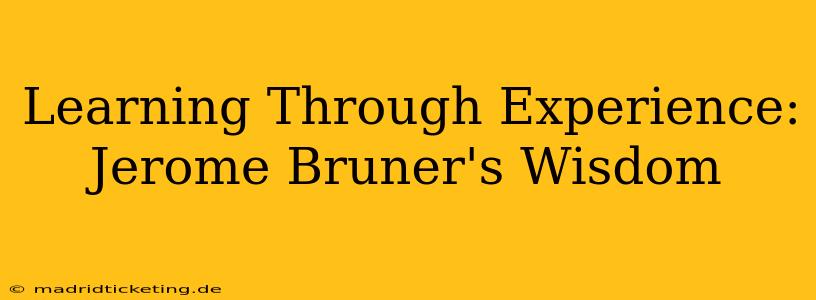Jerome Bruner, a highly influential American psychologist, profoundly impacted our understanding of learning. His work emphasizes the crucial role of experience in shaping knowledge and understanding. This article delves into Bruner's key contributions, exploring his theories and their enduring relevance in education and beyond. We'll examine his constructivist approach, focusing on how learners actively construct knowledge through exploration and interaction with their environment.
What is Bruner's Theory of Cognitive Development?
Bruner's theory of cognitive development centers on the idea that learning is an active process. It's not simply about absorbing information passively; instead, learners construct their own understanding of the world through experience and interaction. He proposed three modes of representation:
- Enactive Representation (0-1 year): This involves learning through actions and manipulating objects. A baby learning to grasp a rattle is a prime example. Understanding is tied directly to physical experience.
- Iconic Representation (1-6 years): Learning occurs through images and mental pictures. Children at this stage can understand concepts represented by pictures or drawings, even if they can't yet fully grasp abstract ideas.
- Symbolic Representation (7 years onwards): This involves using symbols, such as language and mathematical notation, to represent knowledge. Abstract concepts and complex ideas become accessible through the use of symbolic systems.
Bruner believed that progression through these modes isn't strictly linear. Individuals may use different modes depending on the context and the complexity of the information.
What are the Main Principles of Bruner's Theory?
Bruner's theory rests on several core principles:
- Discovery Learning: Bruner championed discovery learning, encouraging learners to actively explore and construct their understanding rather than passively receiving information. He believed that the process of discovery itself is crucial for learning.
- Spiral Curriculum: This involves revisiting fundamental concepts repeatedly throughout education, each time adding greater depth and complexity. This allows for a deeper understanding as learners' cognitive abilities develop.
- Structure of Knowledge: Bruner emphasized the importance of teaching the underlying structure of a subject. By understanding the fundamental principles, learners can better grasp new information and apply it in various contexts.
- Readiness for Learning: While recognizing the importance of developmental stages, Bruner argued that children are often capable of understanding more complex concepts than previously thought, provided they are presented appropriately.
How Does Bruner's Theory Apply to Education?
Bruner's ideas have had a lasting impact on educational practices. His emphasis on active learning, discovery, and the spiral curriculum has influenced countless teaching methodologies. Teachers using Bruner's principles often employ:
- Inquiry-based learning: Students are encouraged to ask questions, investigate, and explore topics independently.
- Problem-solving activities: Learning is framed around problem-solving, encouraging active engagement and critical thinking.
- Collaborative learning: Students work together to construct knowledge and share understanding.
What are Some Criticisms of Bruner's Theory?
While influential, Bruner's theory isn't without its criticisms. Some argue that:
- Discovery learning can be inefficient: Without guidance, learners might struggle to discover key concepts efficiently.
- The spiral curriculum can be challenging to implement: Requiring careful planning and coordination across different grade levels.
- Readiness for learning is subjective: Determining when a child is "ready" for more complex concepts can be difficult.
How Does Bruner's Theory Differ from Piaget's Theory?
Both Bruner and Piaget were influential developmental psychologists, but their theories differ in several key aspects. While Piaget focused on the stages of cognitive development, Bruner emphasized the processes of learning and the importance of instruction. Piaget believed development dictated what children could learn, whereas Bruner believed appropriate instruction could help children learn more complex concepts earlier than Piaget suggested.
What are the Implications of Bruner's Work Today?
Bruner's work remains highly relevant in today's educational landscape. His emphasis on active learning, discovery, and the importance of the learning process aligns perfectly with contemporary approaches to education that prioritize student-centered learning and deeper understanding. His insights continue to inform innovative teaching practices and curriculum design, reinforcing the importance of experience-based learning in shaping knowledge and understanding.
This exploration of Jerome Bruner's contributions offers a glimpse into a profound and lasting influence on educational theory and practice. His emphasis on active learning, discovery, and the construction of knowledge through experience continues to shape how we approach education today.

